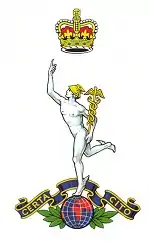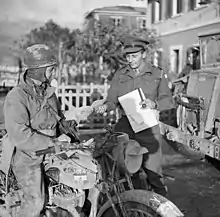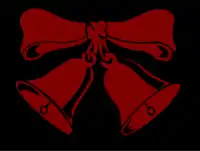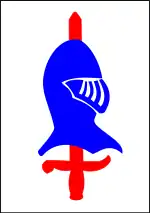City of London Signals
The City of London Signals was a Territorial Army unit of the British Army's Royal Corps of Signals. It had its origins in a signal company of the Royal Engineers formed in 1908 and during World War II it provided the divisional signals for the 56th (London) Division and its duplicates as well as communications for the Royal Air Force in the Middle East. Its successors continued in the postwar Territorial Army and Army Reserve until 2016.
| 56th (1st London) Divisional Signals (City of London) London Divisional Signals (City of London Signals) 56 Signal Squadron | |
|---|---|
 Badge of the Royal Corps of Signals | |
| Active | 1920–1967 1977–2016 |
| Country | |
| Branch | |
| Role | Signals |
| Part of | 56th (London) Division |
| Garrison/HQ | Gray's Inn Road Clapham Park Chelsea, London Eastbourne |
| Engagements | North African Campaign Operation Avalanche Anzio Gothic Line Argenta Gap |
Origin
When the Royal Corps of Signals was created in 1920 the 56th (1st London) Divisional Signals[lower-alpha 1] was formed in the Territorial Army (TA). It was reformed from the former 1st London Divisional Signal Company of the Royal Engineers (RE), which had served through World War I.[3][4]
Royal Engineers
When the old Volunteer Force was subsumed into the Territorial Force after the Haldane reforms in 1908, the East London (Tower Hamlets) Engineers provided the RE components of the Territorial Force's 1st London Division, including the 1st London Divisional Telegraph Company, RE, with the following organisation:[3][4][5][6][7]

* Company Headquarters (HQ) at 10 Victoria Park Square, Bethnal Green
- No 1 Section at 10 Victoria Park Square
- No 2 (1st London) Section
- No 3 (2nd London) Section
- No 4 (3rd London) Section
Nos 2–4 Sections were attached to and largely manned by the three infantry brigades of the division. The Telegraph Company was redesignated a Signal Company in 1911.
The 1st London Division mobilised on the outbreak of World War I in August 1914, and the 1st London Brigade, with No 2 Signal Section, was sent on 4 September to relieve the Regular Army garrison of Malta. The rest of the division's infantry and artillery was progressively sent to France to reinforce the Regulars of the British Expeditionary Force. In February 1915 HQ and No 1 Section of the Signal Company were assigned to 29th Division, newly formed from Regular units brought back from colonial garrisons. On 25 April the division landed at Cape Helles on the Gallipoli Peninsula, and it served through the Gallipoli Campaign until the final evacuation in January 1916. It was then transferred to the Western Front, where it attacked Beaumont-Hamel on the First day on the Somme and then served through the battles of Arras, Third Ypres and Cambrai in 1917 and the German Spring Offensive and Allied Hundred Days Offensive in 1918. After the Armistice the division was sent into Germany as part of the British Army of the Rhine. Following demobilisation of remaining Territorial Force elements, the signal company was converted into Southern Division Signals in Germany in November 1919. A Regular unit, this continued until the division disbanded in 1923[3][4][7][8][9][10]
Shortly after mobilisation in 1914, the Territorial Force raised 2nd Line units with the same titles as the parents, but with a '2/' prefix, including the 2/1st London Divisional Signal Company in the 58th (2/1st London) Division. This incorporated Nos 3 and 4 Sections of the 1st Line company, which had been left in England when their brigades went overseas piecemeal. In January 1916 the 1st London Division began to reform in France as the 56th (1/1st London) Division, and the whole of 2/1st London Signal Company left 58th Division and joined the reformed division on 16 February as 56th (London) Signal Company.[lower-alpha 2] The 56th Division attacked the Gommecourt Salient on the first day on the Somme, and then served through Arras, Ypres, Cambrai and the battles of 1918. After the Armistice Divisional HQ was demobilised in May 1919.[3][4][7][9][11]
Royal Corps of Signals
The new 56th (1st London) Divisional Signals was formed in 1920 as part of the new Royal Corps of Signals in the reorganised Territorial Army, based at 3 Henry Street, Gray's Inn Road, later moving a short distance to 51 Calthorpe Street.[3][4][5] By the 1930s, 56th (1st London) Signals HQ also administered two units of the Supplementary Reserve (SR) at Calthorpe St:[5]
- No 1 (City of London) Company, Line of Communication Signals
- No 1 (City of London) Base Signal Company, Line of Communication Signals
In the 1930s the unit was awarded the supplementary title City of London Signals, but moved its HQ from central London to Signal House, 20 Atkins Road, Clapham Park, accompanied by the SR units, which had expanded into:[5][13]
- HQ Line of Communication Signals
- No 1 Company, Line of Communication Signals
- No 4 (City of London) Company, Line of Communication Signals
- No 21 (City of London) Cable Section
- No 21 (City of London) Construction Section
- No 22 (City of London) Construction Section
- No 3 (City of London) Air Wing Signal Section
Haberdashers' Aske's Hampstead School Cadet Corps (as 1st Cadet Signal Company) and the City of London Signals Cadet Company were affiliated to the unit.[5] The unit's motorcycle despatch riders formed a display team that performed at the Royal Tournament in 1937, precursors of the Royal Signals Motorcycle Display Team (the White Helmets).[3]
In 1935 47th (2nd London) Division was converted into 1st Anti-Aircraft Division and its remaining units were merged into 56th (1st London) Division, which was redesignated simply The London Division, and the signals unit as London Divisional Signals (City of London Signals). The London Division was converted into a Motor Division in 1937.[3][4][5]
World War II
Mobilisation
When the Territorial Army was doubled in size after the Munich Crisis, the division was duplicated and 1st and 2nd (London) Motor Divisional Signals were formed at Clapham in 1939. Later in the same year the 1st London also formed the London Area Signal Company, which in 1940 became London District Signals[lower-alpha 3] providing headquarters communications.[3][4][14]
Organisation

In 1939, the organisation of an infantry divisional signal unit and the attachments of its subunits were as follows:[15]
- HQ
- Q Section – quartermasters
- M Section – maintenance
- 1 Company – Divisional HQ
- A & C Sections – wireless
- B Section – cable
- D Section – despatch riders and cipher section
- O Section – operating
- 2 Company – divisional artillery
- E, F & G Sections – individual artillery regiments
- H Section – HQ divisional artillery
- 3 Company – infantry brigades, reconnaissance and RE
- R Section – reconnaissance battalion
- J, K & L Sections – individual infantry brigades
- 4 Company – attached army tank brigade
- W Section – army tank brigade
- X, Y & Z Sections – individual tank regiments
As the war progressed divisional signals was enlarged to cover the divisional radio telephony (R/T) and wireless telephony (W/T) nets, divisional administrative services, rear communications for brigade HQs, divisional tactical HQ, and air communications.
56th (London) Divisional Signals

1st London Division (it dropped the 'Motor' designation in June 1940) was not sent to join the new British Expeditionary Force in France but remained in the UK. After the Dunkirk evacuation the division held the critical south-east corner of England throughout the period of greatest invasion threat. It regained its traditional title as 56th (London) Infantry Division on 18 November 1940.[17][18]
From November 1940, 56th (L) Division alternated with 43rd (Wessex) Infantry Division, being based at Maidstone and the Medway towns until February 1941 and then again from June. In November 1941 the division drove through London to join XI Corps in East Anglia. The division was now fully equipped and undergoing intensive training and in June it came under War Office control while it mobilised for overseas service.[17][19]
Middle East and North Africa
During August 1942 the division moved to the embarkation ports of Liverpool and Glasgow, and sailed for the Middle East on 25 August. The fast troop convoy reached South Africa safely, but the slow convoy carrying guns and vehicles was heavily attacked by U-boats off the coast of West Africa and lost several ships. From South Africa most of the troops sailed to Bombay, then on to Basra in Iraq, arriving on 4 November and then by road and rail to Kirkuk. 56th Division spent the winter of 1942–43 training for mountain warfare. In March, 168th (2nd London) Brigade with accompanying units was detached to Palestine. Then the rest of the division began an overland drive to join Eighth Army in Tunisia, driving some 3,200 miles (5,100 km) between 18 March and 19 April.[17][20][21]
On 23 April 56th (London) Division went into action for the first time at Enfidaville. The infantry were roughly handled and suffered heavy casualties. The final attack on Tunis (Operation Strike) began on 6 May, the division meeting strong resistance before the Germans surrendered on 12 May. By the end of the month 56th (L) Division had been pulled back to Tripoli to train for the invasion of Italy.[17][22][23][24]
Operation Avalanche
56th (London) Division landed as the right hand half of X Corps at Salerno before dawn on 9 September 1943 in Operation Avalanche. There was bitter fighting for 10 days in the Salerno beachhead and support troops frequently found themselves in the firing line holding off German counter-attacks.[25][26]
On 22 September the Allies broke out and X Corps headed north towards Naples. The retreating Germans had blown every bridge across the River Sarno for 8 miles (13 km) inland, but 56th Division captured an intact bridge at San Mauro and continued past Naples to Capua, where the Germans were making a stand on the River Volturno. Assault crossings of rivers now became a feature of the campaign, and the signal units had to make special arrangements at assembly points, ensure waterproofing of equipment, and provide beachhead communications on the far side. Divisional HQs normally operated as Main and Rear echelons, sometimes with a small Tactical HQ. During phases of mobile warfare a Main HQ could move every day, and wireless and despatch riders had to be used until lines could be re-established.[27][28][29]

The division's attempt to cross the Volturno was repulsed, but the neighbouring divisions got across, and 56th (L) crossed by a US-built bridge. 168 Bde Group rejoined 56th (L) Division at Caserta during these operations. After the Volturno, X Corps made rapid progress up Highway 6 until it reached the Bernhardt Line in the mountains round Monte Camino. There was bitter fighting on Monte Camino itself that lasted until its capture on 9 December, when the division was rested.[30][31] The next obstacle in front of X Corps was the lower Garigliano river south of Monte Cassino. 56th (London) Division's attack on the night of 17 January launched the Battle of Monte Cassino. However, fierce counter-attacks prevented X Corps from advancing far beyond the river.[32][33]
Anzio
On 30 January, 168 Bde was about to resume the offensive on the Garigliano when it was hurriedly withdrawn to reinforce the landing further up the coast at Anzio, which had run into trouble. On 6 February the rest of 56th Division was also withdrawn from the Garigliano and landed as reinforcements at Anzio. The infantry were continually engaged in the Anzio beachhead, and by 25 February were down to less than half strength. On 9 March the exhausted division was evacuated from Anzio.[17][34][35]
56th Division was now went back to Egypt for rest. On arrival at Port Said it went into camp, leave was granted, and training resumed. On 10 July the refitted division left Port Said to return to Taranto, from where it was sent to join V Corps with Eighth Army on the Adriatic coast of Italy.[17][36][37]
Gothic Line
Massive preparations were required for Eighth Army's assault on the Gothic Line (Operation Olive). V Corps opened the attack on 25 August, and by 1 September the Gothic Line had been cracked open, but 56th (L) Division coming up from reserve still had hard fighting at Monte Capello, Montefiore Conca village and the Gemmano ridge. It finally took Gemmano village on 9 September. After a short rest, the division advanced on 16 September and fought its way to the swollen Fiumicino river by the beginning of October. On 7 October the exhausted division was withdrawn.[38][39]
Argenta Gap
In the middle of December the division returned to the line, moving via Forlì to Faenza, where it spent the winter months.[40][41] For 56th (L) Division the Spring 1945 offensive in Italy began on 5 April with an operation to clear a triangle of ground between the River Reno and the south-west corner of Comacchio Lagoon.[42][43] On the night of 10/11 April 56th Division launched Operation Impact Plain to widen the bridgehead and open the 'Argenta Gap' and on 16 April it took Bastia in Operation Impact Royal.[44][45]
On 25 April the division reached the River Po. This was a formidable obstacle, and 56th (L) Division planned to make an assault crossing that night. In the event the infantry got across by storm boat in the afternoon to occupy Crespino, and the river assault after nightfall was almost unopposed.[46][47] The division pushed on to the Adige, where it crossed near Rovigo. 56th (London) Division and 2nd New Zealand Division were given the task of capturing Venice, which they did on 28 April after a brief action. The war in Italy ended on 2 May with the Surrender of Caserta.[48][49]
3rd Air Formation Signals
2nd (London) Motor Divisional Signals was detached from its division at the end of 1939 and reorganised as 3rd Army Signals. After Dunkirk it was redesignated No 2 Headquarters Signals, then again in October 1940 as 3rd Air Formation Signals.[4] Since 1938 the Royal Corps of Signals had provided land communications for Royal Air Force (RAF) HQs overseas through Air Formation Signals (AFS) units.[50] 3rd Air Formation Signals HQ was sent to Middle East Forces at the end of 1940, to be built up to strength by absorbing small units already serving with No 204 Group and other RAF HQs. It left a large cadre in England to reform 47th Divisional Signals (see below).[4]
With the proliferation of RAF HQs in the Middle East, 4th Air Formation Signals was formed in July from Nos 2 and 3 Companies of 3rd AFS. Of these No 2 had been raised in October 1940 and was operating in Cyrenaica, while No 3 had recently returned from the Greek Campaign. 4th AFS was later absorbed into the North Somerset Yeomanry.[51]
No 204 Group was expanded into the Western Desert Air Force in October 1941. This had to be mobile to cooperate with Eighth Army's forthcoming offensive (Operation Crusader): the two fighter wing HQs could leapfrog forwards, and they were split into several flying wings, each with its own landing ground (LG). Three LGs linked by land-line to their parent wing HQ formed a 'fighter airfields area'. As the army and air force advanced, new LGs could be rapidly established, the earlier LGs being taken over by bomber squadrons. All this imposed a heavy burden on the AFS units maintaining communications as the Western Desert Campaign ebbed and flowed in advance and retreat. In 1942, 4th (NSY) AFS was allocated to the Desert Air Force, leaving 3rd AFS to concentrate on 'area' tasks for other RAF HQs in Egypt and the Middle East.[51][52]
In 1943 a standardisation committee regularised the various HQ signal units, and AFS units were supposed to adopt the following organisation:[53]
- 2 Line Troops
- 2 Construction Troops
- 2 Terminal Equipment Troops
- 3 Telegraph Operating Troops
- 2 Despatch Rider Troops (in the Western Desert light trucks frequently replaced DR motorcycles[54])
- 1 Technical Maintenance Troop
- 5 Wing Troops
After the Second Battle of Alamein, followed by Eighth Army's advance into Tunisia and subsequently to Italy, 3rd AFS continued to serve in the Middle East. It was disbanded in September 1945.[4]
47th (London) Divisional Signals

2nd (London) Motor Division dropped the 'Motor' part of its title in June 1940 and was renamed 47th (London) Division on 21 November.[55] 47th (London) Divisional Signals[lower-alpha 4] was reformed from the cadre left behind when 3rd Air Formation Signals went to the Middle East.[4] The division was in reserve behind the anti-invasion formations along the South Coast of England, with winter quarters in Hampshire and Sussex.[55][56][57]
In December 1941 the division was placed on a lower establishment, though still with an operational role in Home Forces. In January 1944 it moved from Hampshire and Dorset District to Northern Command, returning to Southern Command between March and July. After D Day (6 June) reserve units and formations in the UK were required to send large drafts to reinforce 21st Army Group fighting in Normandy. On 15 August 1944 what remained of 47th (L) Division began to disperse: divisional signals was disbanded on 18 August.[55][lower-alpha 5]
Postwar

When the Territorial Army was reconstituted in 1947, 56th (London) Division became an armoured division, with the requisite signal regiment (as Royal Corps of Signals units were now termed) provided by the City of London Signals. 56th (London) Armoured Divisional Signal Regiment (City of London Signals) was based along with the divisional HQ in Chelsea, London. In 1956 the division was reconverted into an infantry division, with consequent reorganisation and redesignation of the signal regiment.[3][4]
During this period a divisional signal regiment was organised as follows:[59]

- Regimental HQ
- Light Aid Detachment, Royal Electrical and Mechanical Engineers
- Communications Section Troop
- HQ Squadron
- Squadron HQ
- Q Troop (quartermasters)
- S Troop (stores)
- M Troop (technical maintenance)
- 1 Squadron
- SHQ
- C Troop (lines)
- O Troop (signal centre)
- R Troop (radio relay)
- 2 Squadron
- SHQ
- A Troop (radio) (Divisional Main HQ)
- B Troop (radio) (Divisional Rear HQ)
In addition, each brigade within the division had its own dedicated signal squadron providing Troops to the armoured and artillery regiments and rear link detachments to infantry battalions.
In 1961 the division was disbanded and 56th (London) Signal Regiment was reduced to 332 Signal Squadron (from 167 Infantry Brigade Signals at Balham). The squadron was assigned to 54 (East Anglian) Signal Regiment, but was disbanded when the Territorial Army was reduced into the Territorial and Army Volunteer Reserve in 1967.[3][4][60]
In 1947 London District Signals was reduced to a mixed squadron ('mixed' indicating that members of the Women's Royal Army Corps were integrated into the unit) and in 1949 to a troop, but in 1952 it was reformed as London District Signal Regiment in the Army Emergency Reserve (the successors of the Supplementary Reserve). In 1959 it was redesignated 87 Signal Regiment (District) and in 1961 was merged into 80 Signal Regiment. This regiment, which had the Communications Zone role, was itself disbanded in 1967.[3][4][61][62]
In 1977 the City of London Signals' traditional number was revived when two troops of 44 (Cinque Ports) Signal Squadron, 858 (Corps) Signal Troop at Eastbourne and 859 Signal Troop from Ilford (which then moved to Sandgate, near Folkestone) were combined to form 56 Signal Squadron under 36 (Eastern) Signal Regiment. Both troops had the role of reinforcing the Regular 22 Signal Regiment at Lippstadt in Germany as part of British Army of the Rhine. In 1982 this role was expanded to reinforcing 2 Infantry Division HQ and Signal Regiment; later it was re-roled as a theatre reserve squadron for British Army of the Rhine Command Communications. In 1990 56 Signal Squadron became independent and then in 1992 it reorganised as a National Communications Squadron and concentrated at Eastbourne. The squadron lost its independent status when it was regimented with 31 (City of London) Signal Regiment in November 1995.[3][63] By 2013 it was part of 39 (Skinners) Signal Regiment but it disbanded by April 2016 under the Army 2020 plans; the Eastbourne Army Reserve centre taken was over by 3rd Battalion Princess of Wales's Royal Regiment with the signals personnel given the option to re-role as infantry.[64]
Commanders
Commanding Officers
The following served as commanding officer of the unit and its successors:[5][4]
56th (1st London) Divisional Signals (City of London), and 1st (London) Motor Divisional Signals
- Maj (later Lt-Col) H. Lloyd-Howard, MC, 1921
- Lt-Col H.F. Fox, TD, 1926
- Lt-Col G.D. Ozanne, MC, 1931
- Lt-Col A.C.C. Willway, 1936
- Lt-Col T.S.A. Campbell, 1941
- Lt-Col C.C. Danby, OBE, 1942
- Lt-Col F.R.B. Moore, 1944
- Lt-Col L.T. Shawcross, OBE
- Lt-Col W.A. Tomlinson
2nd (London) Motor Divisional Signals
- Lt-Col F. White, 1939
- Lt-Col J.H. Cameron-Webb, 1939
3rd Air Formation Signals
- Lt-Col J.H. Cameron-Webb, 1940
- Lt-Col J.R. Sutcliffe, OBE, 1041
- Lt-Col E.B. Tinney, 1943–45
47th Divisional Signals
- Maj Jean Joseph Duvivier, 1939[65]
- Lt-Col G.S.O'N. Power, 1940
- Lt-Col F.W.S. Jourdain, 1940
- Lt-Col R.W.C. Reeves, 1942
- Lt-Col H.C.B. Rogers, OBE, 1943
- Lt-Col J.R.S. Orchard, TD, 1943
- Lt-Col A. Hill, OBE, 1944
London District Signals
- Maj (later Lt-Col) B. Houghton Brown, 1939
- Lt-Col W.J. Pearce, 1943
- Lt-Col H.V. von S. Thorne, OBE, 1943
- Lt-Col W.E. Pain, MC, 1944
56th (London) Armoured Divisional Signal Regiment (City of London Signals), TA
- Lt-Col N.C. Pearson, OBE, TD, 1947
- Lt-Col T.E. Dobson, 1948
- Lt-Col F.R. Hue Williams, OBE, TD, 1951
- Lt-Col K.C. Goldie-Morrison, TD, 1956
London District Signal Regiment, AER
- Lt-Col G.H.T. Shrimpton, TD, 1952
Honorary Colonels
The following officers served as Honorary Colonel of the unit:[5]
- Col Jacob Waley-Cohen, CMG, CBE, DSO, TD, appointed 30 June 1928; later Hon Col HQ LoC Signals (SR), appointed 17 October.[66]
- Lt John Denison-Pender, director of Cable & Wireless, appointed 6 December 1933, created Lord Pender 1937.
- Brig A.C.C. Willway, CB, CBE, TD, former CO, 1945–56[67]
Footnotes
- Divisional signal units of the Royal Signals 1920–45 were battalion-sized and commanded by a Lieutenant-Colonel or Major; they were not termed 'regiments' until 1946.[1][2]
- 1/1st London Signal Co was replaced in 58th Division by 2/1st Wessex Signal Co, whose parent 45th (2nd Wessex) Division had gone to garrison India.[11][12]
- Not to be confused with the pre-World War I London District Signals, which in World War II provided communications for anti-aircraft formations in the London area.
- Not to be confused with 47th (2nd London) Divisional Signals, 1920–35.
- A new 47th (Reserve) Division was formed on 1 September 1944, simply by redesignating the existing 76th Division with its own signals and support units.[55][58]
Notes
- Lord & Watson, p. 21.
- Nalder, p. 477.
- Lord & Watson, pp. 168–70.
- Nalder, Appendix 4, pp. 606–7.
- Monthly Army List, various dates.
- London Gazette, 20 March 1908.
- Becke, Pt 2a, pp. 141–7.
- Becke, Pt 1, pp. 117–24.
- Lord & Watson, pp. 222–3.
- Nalder, p. 156.
- Becke, Pt 2b, pp. 9–15.
- Becke, Pt 2a, pp. 55–60.
- Lord & Watson, p. 243.
- Lord & Watson, p. 244.
- Lord & Watson, pp. 262, 314.
- Edwards, pp. 177, 195, 218.
- Joslen, pp. 37–8.
- Collier, p. 125, Maps 5, 6, 17, 20.
- Edwards, pp. 127–32.
- Edwards, pp. 131–3.
- Playfair & Molony, Vol IV, pp. 441–2, 453.
- Edwards, p. 134.
- Playfair & Molony, Vol IV, p. 453.
- Molony, Vol V, p. 259.
- Edwards, pp. 136–8.
- Molony, Vol V, pp. 276–7, 291–2, 296, 310, 321.
- Edwards, pp. 138–9.
- Molony, Vol V, pp. 337–42, 439–40.
- Nalder, pp. 406–7.
- Edwards, pp. 140–1.
- Molony, Vol V, pp. 444, 450–3, 517–8.
- Edwards, pp. 142–3.
- Molony, Vol V, pp. 606–16, 632–4.
- Edwards, pp. 143–4.
- Molony, Vol V, pp. 635–6, 744, 754–7.
- Edwards, p. 145.
- Molony, Vol V, p. 757.
- Edwards, pp. 146–8.
- Jackson, Vol VI, Pt II, pp. 225–6, 231–2, 249–52, 260–1, 267–8, 277, 353–4, 402–4.
- Edwards, p. 149.
- Jackson, Vol VI, Pt III, pp. 120–4.
- Edwards, pp. 149–51.
- Jackson, Vol VI, Pt III, pp. 215–6, 259–60.
- Edwards, pp. 151–2.
- Jackson, Vol VI, Pt III, pp. 267–8, 271–3, 281, 283.
- Edwards, p. 152.
- Jackson, Vol VI, Pt III, pp. 295, 319.
- Edwards, pp. 152–3.
- Jackson, Vol VI, Pt III, pp. 324, 326, 332.
- Lord & Watson, p. 310.
- Nalder, pp. 318, 629.
- Playfair, Vol III, pp. 12–3.
- Lord & Watson, p. 265.
- Nalder, p. 297.
- Joslen, pp. 41–2.
- Edwards, pp. 180–4
- Collier, Map 20.
- Joslen, p. 99.
- Lord & Watson, pp. 202–5, 280–1.
- Lord & Watson, pp. 166, 205.
- Lord & Watson, pp. 211–2.
- Nalder, pp. 474, 478.
- Lord & Watson, pp. 137, 208.
- Army 2020 Reserve Structure and Basing.
- Nalder, Appendix 3, p. 521.
- Nalder, Appendix 3, p. 580.
- Nalder, Appendix 3, p. 578.
References
- Maj A.F. Becke,History of the Great War: Order of Battle of Divisions, Part 1: The Regular British Divisions, London: HM Stationery Office, 1934/Uckfield: Naval & Military Press, 2007, ISBN 1-847347-38-X.
- Maj A.F. Becke,History of the Great War: Order of Battle of Divisions, Part 2a: The Territorial Force Mounted Divisions and the 1st-Line Territorial Force Divisions (42–56), London: HM Stationery Office, 1935/Uckfield: Naval & Military Press, 2007, ISBN 1-847347-39-8.
- Maj A.F. Becke,History of the Great War: Order of Battle of Divisions, Part 2b: The 2nd-Line Territorial Force Divisions (57th–69th), with the Home-Service Divisions (71st–73rd) and 74th and 75th Divisions, London: HM Stationery Office, 1937/Uckfield: Naval & Military Press, 2007, ISBN 1-847347-39-8.
- Basil Collier, History of the Second World War, United Kingdom Military Series: The Defence of the United Kingdom, London: HM Stationery Office, 1957.
- Maj D.K. Edwards, A History of the 1st Middlesex Volunteer Engineers (101 (London) Engineer Regiment, TA) 1860–1967, London, 1967.
- Gen Sir William Jackson, History of the Second World War, United Kingdom Military Series: The Mediterranean and Middle East, Vol VI: Victory in the Mediterranean, Part II: June to October 1944, London: HM Stationery Office, 1987/Uckfield, Naval & Military Press, 2004, ISBN 1-845740-71-8.
- Gen Sir William Jackson, History of the Second World War, United Kingdom Military Series: The Mediterranean and Middle East, Vol VI: Victory in the Mediterranean, Part III: November 1944 to May 1945, London: HM Stationery Office, 1988/Uckfield, Naval & Military Press, 2004, ISBN 1-845740-72-6.
- Lt-Col H.F. Joslen, Orders of Battle, United Kingdom and Colonial Formations and Units in the Second World War, 1939–1945, London: HM Stationery Office, 1960/Uckfield: Naval & Military Press, 2003, ISBN 1-843424-74-6.
- Cliff Lord & Graham Watson, Royal Corps of Signals: Unit Histories of the Corps (1920–2001) and its Antecedents, Solihull: Helion, 2003, ISBN 1-874622-92-2.
- Brig C.J.C. Molony,History of the Second World War, United Kingdom Military Series: The Mediterranean and Middle East, Vol V: The Campaign in Sicily 1943 and the Campaign in Italy 3rd September 1943 to 31st March 1944, London: HM Stationery Office, 1973/Uckfield, Naval & Military Press, 2004, ISBN 1-845740-69-6.
- Maj-Gen R.F.H. Nalder, The Royal Corps of Signals: A History of its Antecedents and Developments (Circa 1800–1955), London: Royal Signals Institution, 1958.
- Maj-Gen I.S.O. Playfair, History of the Second World War, United Kingdom Military Series: The Mediterranean and Middle East, Vol III: (September 1941 to September 1942) British Fortunes reach their Lowest Ebb, London: HM Stationery Office, 1960 /Uckfield, Naval & Military Press, 2004, ISBN 1-845740-67-X.
- Maj-Gen I.S.O. Playfair & Brig C.J.C. Molony, History of the Second World War, United Kingdom Military Series: The Mediterranean and Middle East, Vol IV: The Destruction of the Axis forces in Africa, London: HM Stationery Office, 1966/Uckfield, Naval & Military Press, 2004, ISBN 1-845740-68-8.